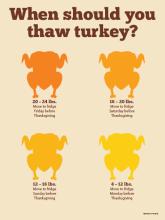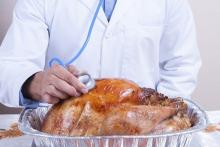Top 10 Tips to Keep Your Holiday Dinner Safe
Top 10 Tips to Keep Your Holiday Dinner Safe
Tip 1: Wash Your Hands
Wash your hands frequently and thoroughly throughout food preparation and cooking, especially after you’ve handled raw meats or poultry.
Tip 2: Prevent Cross-Contamination
Store raw meat and poultry in the bottom of your refrigerator where juices can’t drip onto foods that will not be cooked.
Wash your cutting boards, dishes, utensils and counter tops with hot, soapy water after preparing each food item, and before moving on to the next dish. Rinse with clean water, and then use a small amount of chlorine bleach mixed with water (1/2 tablespoon bleach per ½ gallon of water) on all surfaces.
Tip 3: Homemade Egg Nog
Remember that raw eggs can carry dangerous bacteria like Salmonella. If you make your own egg nog, remember to use pasteurized eggs. Pasteurized eggs typically come as a liquid product in a carton similar to milk, but some stores also carry eggs that have been pasteurized in their shells.

Tip 4: Frozen vs. Fresh Turkey, Duck or Goose
For frozen birds, allow at least 24 hours of thawing time for every 5 pounds of raw poultry. Thaw the bird in the refrigerator at 41°F or below in its original wrapping. (Never thaw at room temperature as warm temperatures promote bacterial growth.) Other safe methods of thawing include: under cold running water that is 70°F or less, or in a microwave. (If you choose to microwave, you’ll need to cook the bird right away.)

USDA advises that you cook a fresh bird within two days of purchase or freeze it.
Tip 5: Preparation of Poultry
Remove giblets from the bird cavity before cooking separately or discarding.
Do not wash the bird. Studies have shown recently that the juices (and therefore harmful bacteria) can be spread up to four feet from your sink during the washing process.
For optimum safety, do not stuff the inside of a bird. Ideally, stuffing should be cooked separately and then checked to be sure that it reaches an internal temperature of 165°F. If you stuff your bird, make sure both the meat AND the stuffing reaches 165°F.
Tip 6: Cooking Turkey
To know if food has been thoroughly cooked, use a metal stem food thermometer to check the internal food temperature. For safety, cook the turkey until all internal temperatures reach 165°F.
Tip 7: Special Holiday Meats
USDA offers great advice on how to handle and roast holiday meats other than turkey or chicken (including beef roasts, lamb, pork, ham, venison, and more).
Tip 8: Cooking
To know if food has been thoroughly cooked, use a metal stem food thermometer to check the internal food temperature. For safety, cook poultry until all internal temperatures reach 165°F; cook beef and pork to 145°F. For ground meats, cook to 155°F.
Consult the USDA Fact Sheet for more detailed information on cooking.
Tip 9: Leftovers
Don’t leave perishable foods at room temperature. Keep hot foods hot (at least 135°F) and cold foods cold (41°F or below).
Discard any leftovers that have been at room temperature for longer than 2 hours.
Divide leftovers into small portions. Refrigerate or freeze in shallow containers for quicker cooling.
Cooked foods should be cooled:
• Within 2 hours, from 135°F to less than 70°F, and
• Within a total of 6 hours to 41°F or less.
Tip 10: Reheating Leftovers
Thoroughly re-heat any leftovers to an internal temperature of 165°F.
Enjoy
By following these simple tips, we hope that you will have a safe and enjoyable holiday! You can also visit USDA’s site or the Story of Your Dinner Infographic for other holiday tips.